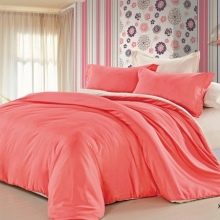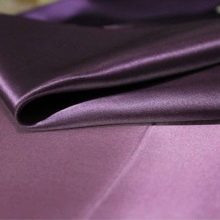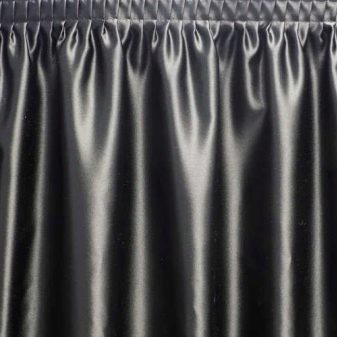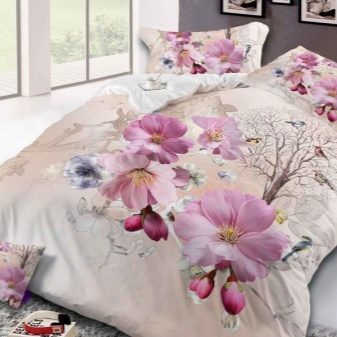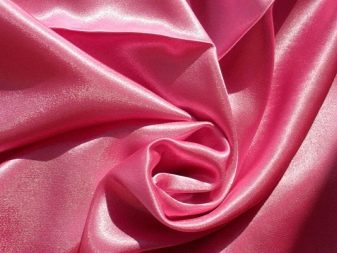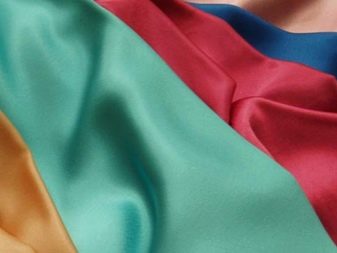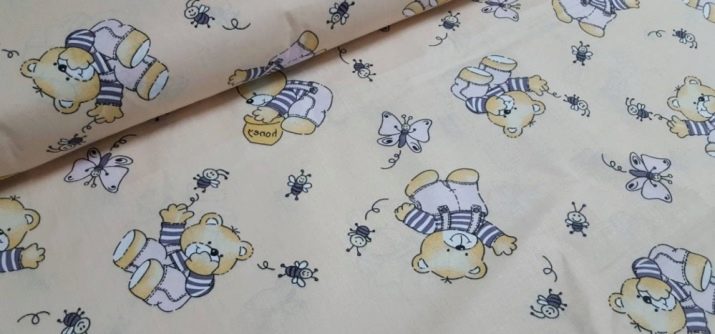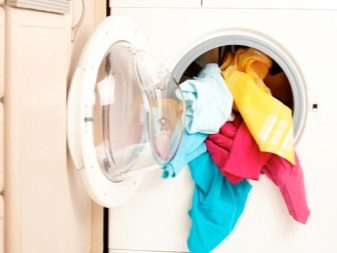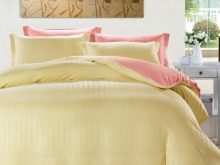Polisatin: what is this fabric, composition and characteristics

Today, one of the most sought-after fabrics is polysatin, which successfully replaces its satin precursor. This material is rather unusual in that all fibers undergo special processing before weaving, so that the fabric becomes perfectly flat and smooth.
Description
If you mix coal, oil, water and air, then the result is a synthetic additive, which is called polyester. It is this substance that became part of polysatin, due to which the fabric acquired strength, exceptional durability, resistance to the appearance of creases and deformations.
Things from this canvas are very convenient, they do not require ironing, they almost do not shrink and look great even on the lightest coloring. The second component of the canvas - cotton fiber. As a rule, modern materials contain 35% polyester and 65% cotton.
The material is thin, smooth, silky surface. The density of threads varies from 70 to 100 g / m2. The popularity of the material is due to its exceptionally high technical and operational characteristics.
- Durability. The material is resistant to wear, does not fade, does not fade in the sun, is designed for frequent washing and intensive socks.
- Strength. Double weave of threads provides resistance to tearing.
- Unpretentiousness. Polyester products are easy to wash, even when heavily soiled. They dry out very quickly, without being wrinkled, that is, they can be put on immediately after washing and drying (without steaming and smoothing).
- Convenience in tailoring. The material is easily cut and sewn, it does not crumble, the edges do not unfold and do not curl.
Many people note the durability and breathability of polysatin. However, these qualities are pleasing when you need to sew a canopy, an awning or a raincoat, but such fabrics are not suitable for casual wear: they will not be completely comfortable, the body will not “breathe”, and this often causes various allergic reactions.
Kinds
Depending on the raw materials used and features of use, there are two types of polyester.
Industrial
Composed of 100% polyester, used for the manufacture of bags, mattresses, furniture upholstery, rugs, awnings and similar products. Throughout the period of use, synthetics does not lose its shape, does not change color and does not wear out. Products made from industrial polyester are perfectly cleaned, although the smooth surface itself almost does not absorb pollution, but rather repels them, which greatly simplifies maintenance.
Some manufacturers sew bedding from this material, but they are not popular with consumers.
Domestic
This is a blended material that is used to make clothes and bedding. In recent years, fabrics with 3D patterns are being at the peak of demand, which are obtained thanks to a special technology of photonapplication of vivid pictures. The image looks very colorful and realistic and does not lose its colors even after repeated washings.
Comparison with other materials
After the appearance on the domestic market, polysatin began to be positioned as a material to replace such traditional fabrics as satin, microfiber and many other natural canvases. We will try to answer the question whether this fabric can be an analogue of other canvases.
- Satin. Weave from double-twisted fibers that have previously been processed for a smooth structure. The result is a dense canvas, but silky, smooth and thin. This is a completely natural material, and this is its main difference from polysatin, which is either a mixture of synthetics and cotton, or a completely synthetic material. That is why satin is much more expensive than polysatin, although things from it wear out faster and lose their original gloss.
- Poplin. It is a material made of fibers of different thickness, as a result, a dense header is obtained. Poplin can be made of 100% cotton, and may contain inclusions of silk, wool or artificial fibers. Such material is hypoallergenic and very pleasant to the body by touch. Like polisatin, poplin does not wrinkle, does not require special care and is worn for quite a long time. Polysatin, especially if it contains a lot of polyester, is less pleasant for the skin, it can electrify and in rare cases cause irritation. However, it costs much less poplin, because it is in great demand.
- Calico. The fabric structure here is the same as that of poplin, but the fibers are coarser. The fabric is completely cotton, so it is widely used for the manufacture of sets of bed linen and other household items. This is a safe and practical matter, and in these parameters the calico benefits polyester, however, polysatin is softer and more tender to the touch, and it is estimated to be slightly cheaper.
Summarizing all the above, we can conclude that polisatin, in the structure of which cotton is present, is almost not inferior to cotton linen, but it is much cheaper.
If the body does not respond to artificial fibers, then it is quite possible to save a little.
Care
Polisatin is very easy to maintain, the only precaution when working with this material is the need to observe the temperature during washing and ironing. Fabric easily transfers all cycles and modes of machine and hand washing, the temperature should be set no higher than 40 degrees. If you wash clothes at higher temperatures, it will quickly become useless.
When choosing detergents, it is better to give preference to formulations without chlorine. This will preserve the brightness of colors and clarity of 3D images. Experts advise the use of liquid and gel products.
It is advisable to use air conditioning when working with the canvas: it maintains the softness of the fabric and the saturation of the colors.
Polyester products dry very quickly. It is best to dry them in the air, they do not lose their properties under the influence of ultraviolet radiation, but long-term drying under the open rays of the sun is undesirable. The material can be used immediately after washing and drying, because it does not hesitate, but experienced housewives advise that slightly undressed laundry should be gently folded with a stack and left on a flat, firm surface for several hours. In this case, the products will look like new, as if just “out of the package.”
If the fabric still has creases, then polisatin should be ironed only on weak heating modes and only on the wrong side. It is imperative to use a fabric gasket, although in most cases you can simply moisten the cloth with a spray bottle and dry it straightened.
Reviews
Opinions of users about polysatin in most cases positive. Buyers claim that it is a practical material for everyday use: it does not wrinkle, is easy to wash and almost does not get dirty. Many say that they use a bed of such material for 3-4 years: it does not lose its appearance and operational parameters. Sheets, pillows and duvet cover made of polyester perfectly absorb moisture, which is of fundamental importance in hot summer weather.
It is noteworthy that the products have fairly affordable prices, but the appearance is exceptionally stylish and presentable. Modern inhabitants with their fast pace of life are quite comfortable using underwear made from this fabric, since caring for them takes almost no time. However, for children and people prone to allergies, it is better to give preference to all-natural materials.
In the next video you will find useful information about the choice of bed linen.
